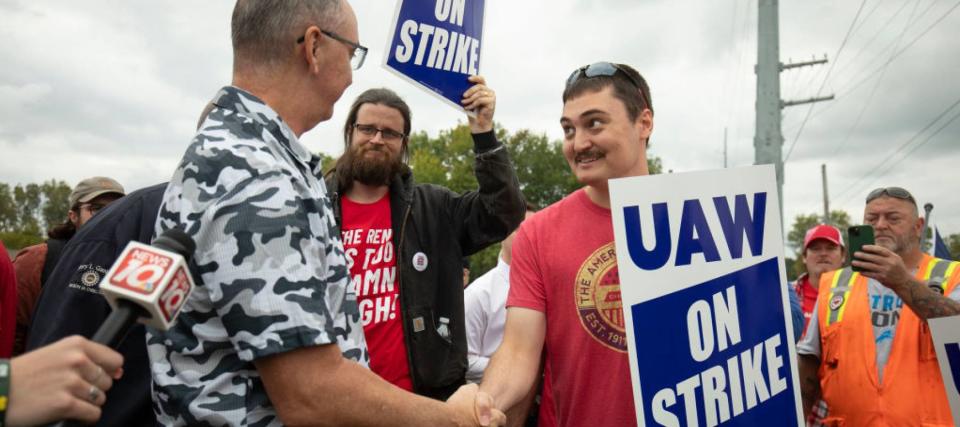Labor unions are having a moment in the sun after seeing 'a summer of strikes' — but who's actually getting burned in the end? These are the pros and cons of unions

It’s been a big win for labor this fall. Alongside the UPS workers' new contract, the 148-day Writers Guild of America (WGA) strike ended. The Hollywood studios conceded to increase royalty payments and protect the writers’ work against AI, according to the almost ratified agreement.
Several other unions are still on strike, with SAG-AFTRA actively negotiating for a new agreement. For their part, the United Auto Workers is said to have reached a tentative deal with General Motors on Oct. 30, effectively ending the strike after the union settled with Ford Motors and Chrysler's owner Stellantis in the previous days, according to Reuters. These unions all want similar things as the writers: more money and more protections around infringing technology.
Don’t miss
Commercial real estate has outperformed the S&P 500 over 25 years. Here's how to diversify your portfolio without the headache of being a landlord
Rich young Americans have lost confidence in the stock market — and are betting on these 3 assets instead. Get in now for strong long-term tailwinds
'A natural way to diversify': Janet Yellen now says Americans should expect a decline in the USD as the world's reserve currency — 3 ways you can prepare
Unions are the reason we have workplace benefits like two-day weekends and laws against child labor, says the United Food and Commercial Workers. But even with these current and historic wins, do the benefits outweigh the drawbacks of unions?
Why are there so many strikes?
Though it may seem like unions are infiltrating every workplace, only 10.1% of workers belong to unions, according to the Bureau of Labor Statistics’ (BLS) most recent estimates — which is half of the 1983 rate. And they're not increasing as you might assume — the BLS noted a 0.2% decrease in union membership in 2022 compared to 2021.
Even though union membership isn’t sky high, we saw the “summer of strikes” for several reasons, including corporations seeing record profits while wages remain stagnant and the cost of living continues to rise. And now, there’s the looming threat of AI replacing workers — something even Ray Dalio has warned his colleagues about.
With these economic shifts, Gallup reported 71% of Americans approve of labor unions — the highest percentage recorded since 1965. Even investing legend Warren Buffett counts himself among their supporters. On the other hand, many Americans are still skeptical or even opposed to unions, including Jeff Bezos and Elon Musk. So who's right?
Read more: Thanks to Jeff Bezos, you can now use $100 to cash in on prime real estate — without the headache of being a landlord. Here's how
The pros
Unions aim to create positive benefits for all workers — not just their individual members. And research shows their efforts have had a massive impact on the face of work in the U.S. From 1930 to 1960, union participation increased and contributed to reducing the income gap across America, according to a 2021 article in the Quarterly Journal of Economics.
A smaller income gap also means that workers have more money to spend — and funnel back into the economy and their own savings. An overwhelming 93% of union workers have access to retirement plans, compared to just 67% of non-union members in 2022, according to BLS data. With many older Americans in the grips of a homelessness epidemic, the government will need to spend more on the welfare of older adults. But advocates argue that if every retiree had these kinds of union retirement savings, more tax dollars could go toward things that benefit everyone directly, like parks, schools and roads.
A newer union benefit is the protections some are creating against technology that could take over jobs. Without proper protections against AI, you and many others could be out of work, which could have a serious impact on the unemployment rate and the strength of the American economy.
The cons
Though workers greatly benefit from unions, corporations don’t always receive the same perks. For instance, if a corporation has to increase wages, like they did with UPS workers in August, there’s less money for the company to either reinvest in the business or hand out to shareholders.
Plus, unions cost money — not just for the corporation, but for workers too. Every month or year, individual workers must pay their dues. And at many unionized workplaces, even if you don’t want to be a member, you can’t work there without being in the union, according to the National Right to Work Foundation.
Unfortunately, some unions have a history with corruption and criminal activity. (Just look at Jimmy Hoffa, a leader in the International Brotherhood of Teamsters with infamous ties to organized crime.) If you end up with poor union leadership who abuse your dues, you’re not likely to see the protections you paid for.
Whether you cross the picket line or not, there’s no getting around the fact that workers are frustrated with corporate America. While the Biden administration and several economists tout the benefits of unions in empowering workers, there are often personal trade-offs involved in acting on behalf of the collective. Deciding which is the lesser of two evils is up to you.
What to read next
Worried about the economy? Here are the best shock-proof assets for your portfolio. (They’re all outside of the stock market.)
Rising prices are throwing off Americans' retirement plans — here's how to get your savings back on track
Jeff Bezos and Oprah Winfrey invest in this asset to keep their wealth safe — you may want to do the same in 2023
This article provides information only and should not be construed as advice. It is provided without warranty of any kind.